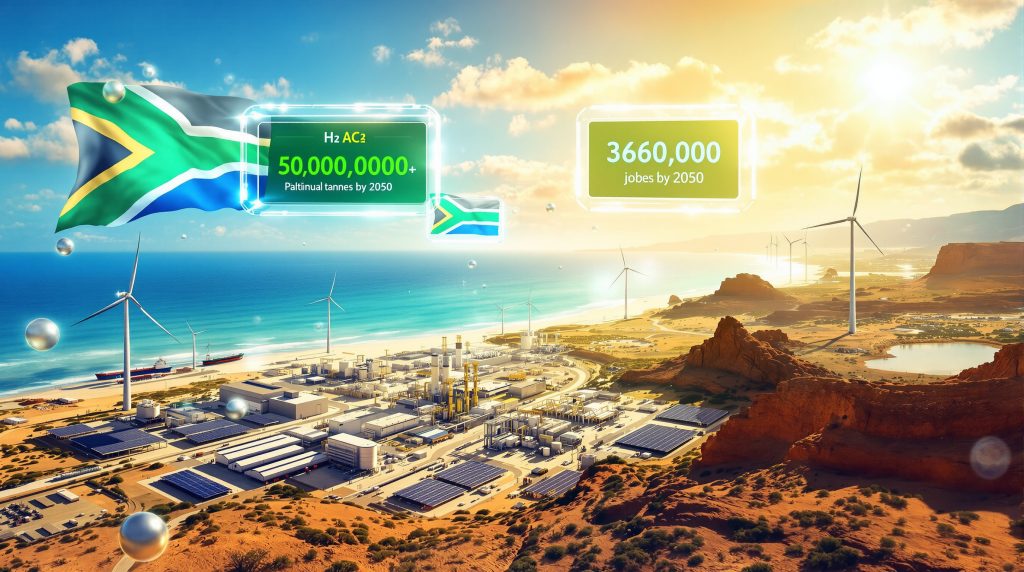Understanding Green Hydrogen's Role in Energy Transition
Green hydrogen represents a revolutionary approach to clean energy production, created through electrolysis powered entirely by renewable energy sources. Unlike its grey counterpart produced from fossil fuels or blue hydrogen with carbon capture technology, green hydrogen in South Africa generates zero emissions during production. This process splits water molecules using electricity from solar panels or wind turbines, creating pure hydrogen that can power everything from heavy industry to transportation networks.
The applications span across multiple sectors, offering particular value in industries where direct electrification proves challenging. Steel production, chemical manufacturing, and long-haul transportation present prime opportunities for hydrogen adoption. Furthermore, the environmental benefits extend beyond immediate carbon reduction, as green hydrogen enables the storage of excess renewable energy for later use, addressing intermittency challenges that have historically limited solar and wind deployment.
Recent developments in electrolyser technology have incorporated platinum group metals (PGMs) as critical components. Iridium finds application in proton exchange membrane systems, while ruthenium serves advanced electrolysis technologies. However, these metals have experienced significant price volatility, with ruthenium achieving record highs driven by industrial demand, though iridium has shown more subdued performance despite its hydrogen sector relevance.
South Africa's Natural Advantages for Green Hydrogen Development
South Africa's geographic positioning creates exceptional conditions for renewable energy generation. The country's solar resources rank among the world's highest, while coastal regions provide consistent wind patterns suitable for large-scale energy production. Consequently, these natural advantages translate into lower production costs compared to regions with less favorable renewable energy conditions.
Industry analysis suggests the European Union recognizes these competitive advantages, viewing South African green hydrogen production as both more economical and environmentally superior to domestic alternatives. The combination of abundant sun and wind resources positions South Africa to serve international markets requiring clean hydrogen imports.
Existing industrial infrastructure provides additional leverage for green hydrogen development. Chemical processing facilities, mining operations, and port systems already established across South Africa can adapt to hydrogen production and export operations. In addition, the strategic location offers proximity to major import markets in Europe and Asia, reducing transportation costs and complexity compared to more distant hydrogen producers.
Current Production Targets and Ambitious Timeline Goals
South Africa has established aggressive targets for green hydrogen development, though specific production volumes require careful verification from official government sources. The Northern Cape region emerges as a primary production hub, leveraging exceptional solar irradiation levels and available land for large-scale renewable energy installations.
Development timelines suggest commercial-scale production could commence within the current decade, with major capacity expansions planned for the 2030s. However, these projections align with global hydrogen market growth forecasts, though successful implementation depends on infrastructure development, financing availability, and regulatory framework establishment.
Regional production zones under consideration span multiple provinces, each offering distinct advantages. The Northern Cape provides optimal solar resources, while coastal areas offer wind energy potential and port access for export operations. Furthermore, integration with existing mining and industrial operations creates synergies that could accelerate project development.
Major International Partnerships Drive Project Development
The European Union has committed substantial financial resources to South Africa's green hydrogen transition through an €11.5 billion investment package. This partnership operates under the Global Gateway initiative, with Team Europe mobilising resources from EU member states and development finance institutions to support comprehensive energy transition programs.
The collaboration extends beyond hydrogen production to encompass sustainable infrastructure development, digital connectivity improvements, and pharmaceutical value chain enhancement. This holistic approach recognises that successful green hydrogen implementation requires broader economic and technological development.
Projects like the Coega green ammonia initiative demonstrate existing progress in South Africa's green energy sector. For instance, these early developments provide proof-of-concept for larger hydrogen production facilities while establishing technical expertise and operational experience necessary for commercial-scale operations.
Economic Benefits Span Multiple Sectors
Green hydrogen development promises significant employment creation across various skill levels and industries. Manufacturing, engineering, operations, and maintenance roles will support both domestic and export-oriented hydrogen production. Consequently, the transition creates opportunities for workforce development in emerging clean energy technologies, alongside the mineral beneficiation opportunities this sector provides.
| Development Phase | Focus Areas | Economic Impact |
|---|---|---|
| 2025-2027 | Pilot projects, infrastructure | Skilled labour demand |
| 2028-2030 | Commercial scaling | Manufacturing jobs |
| 2031-2040 | Export operations | Logistics, maintenance |
Revenue generation opportunities extend beyond direct hydrogen sales to include value-added processing capabilities. Green steel production, clean ammonia manufacturing, and chemical industry applications could generate higher-value exports compared to raw hydrogen sales. Furthermore, the integration with platinum group metals mining creates unique competitive advantages within the broader context of critical minerals and energy transition initiatives.
Government policy frameworks increasingly support hydrogen sector development through various incentive mechanisms. Tax deductions, streamlined regulatory processes, and development finance partnerships aim to accelerate private sector investment and project implementation.
Infrastructure and Water Management Challenges
Water scarcity presents a significant challenge for hydrogen production in South Africa's arid regions. Each kilogram of hydrogen produced requires approximately 30 litres of fresh water, necessitating substantial desalination infrastructure along coastal production zones. This requirement adds complexity and cost to project development while raising environmental and community concerns about water resource allocation.
Grid connection and transmission infrastructure require substantial upgrades to accommodate large-scale renewable energy installations. However, storage and transportation systems for hydrogen present additional technical challenges, particularly for export operations requiring specialised port facilities and shipping infrastructure.
Technical hurdles include electrolyser technology scaling, cost reduction, and reliability improvement. Managing renewable energy intermittency through storage systems or grid balancing adds operational complexity. Consequently, international competitiveness depends on achieving cost parity with hydrogen producers in Australia, Chile, and other emerging markets.
Global Market Position and Competitive Analysis
South Africa's competitive advantages centre on superior renewable energy resources and lower production costs. The country's strategic geographic location provides shorter shipping distances to European markets compared to Australian competitors. Furthermore, existing industrial expertise in mining and chemical processing offers additional competitive benefits.
Comparative Advantages:
• Resource Quality: Exceptional solar irradiation and coastal wind patterns
• Cost Structure: Lower renewable energy production expenses
• Market Access: Proximity to European and Asian import markets
• Industrial Base: Established chemical and mining sector expertise
Global hydrogen market dynamics favour countries with abundant renewable resources and low production costs. Australia focuses on large-scale export facilities, while Chile integrates hydrogen with existing mining operations. However, Middle Eastern countries leverage oil industry experience for hydrogen development, though South Africa's renewable resources provide cleaner production pathways aligned with the country's critical minerals strategy.
Platinum Group Metals Create Unique Advantages
South Africa's position as the dominant global producer of platinum group metals creates distinctive advantages in green hydrogen development. Iridium and ruthenium serve critical roles in advanced electrolyser technologies, with demand growth supporting higher metal prices and improved mining sector economics.
Ruthenium has experienced considerable price rallies driven by industrial demand, reaching record levels during recent periods. Fundamental market strength reflects robust demand from hydrogen production applications, though price volatility creates both opportunities and risks for producers.
Iridium applications in proton exchange membrane systems position this metal as essential for efficient hydrogen production. Despite its critical role, iridium prices have shown more subdued performance compared to ruthenium, potentially reflecting supply-demand imbalances or market sentiment factors.
Supply Chain Integration Benefits:
• Vertical integration opportunities from mining to electrolyser production
• Reduced import dependency for critical electrolyser components
• Technology development and manufacturing potential
• Export value addition beyond raw materials
The combination of renewable energy resources and critical minerals supply creates unique positioning for South Africa in global hydrogen markets. This integration enables cost-effective production while supporting domestic mining and manufacturing sectors as part of broader industry evolution trends.
Timeline for Commercial Scale Development
Green hydrogen industry development follows a phased approach aligned with infrastructure development, market demand, and financing availability. Initial phases focus on pilot project completion and technology demonstration, building toward commercial-scale production in the latter half of the decade.
Development Milestones:
• 2025-2027: Pilot project completion and scaling validation
• 2028-2030: Commercial production ramp-up and infrastructure completion
• 2031-2035: Major export capacity establishment and market penetration
• 2036-2040: Full-scale industrial transformation and sector maturity
Market readiness indicators include international offtake agreement negotiations, infrastructure construction progress, and regulatory framework finalisation. Investment commitment levels and technology cost reductions will determine actual development pace.
The outlook for green hydrogen in South Africa projects becoming more clearly defined enables technologically robust initiatives to attract necessary funding and offtake commitments. This development should provide support for minor metals demand, particularly benefiting South Africa as the largest global producer of these critical materials.
Environmental and Social Impact Considerations
Green hydrogen development offers substantial environmental benefits through carbon emission reductions and industrial decarbonisation acceleration. The technology enables renewable energy sector expansion while reducing fossil fuel dependency across multiple economic sectors.
Community engagement remains essential for successful project implementation. Local employment opportunities, skills development programmes, and infrastructure development in rural areas provide positive social outcomes. However, environmental justice considerations require careful attention to water resource management, land use planning, and waste management from manufacturing processes.
Positive Environmental Outcomes:
• Significant carbon emission reductions across industrial sectors
• Acceleration of renewable energy deployment
• Reduced dependency on fossil fuel imports
• Support for global climate change mitigation efforts
Sustainability challenges include long-term environmental monitoring requirements and community water security concerns in arid production regions. Balancing industrial development with environmental protection requires comprehensive planning and stakeholder engagement.
Investment Opportunities Across the Value Chain
Green hydrogen development creates investment opportunities spanning the entire value chain from renewable energy generation to export logistics. Renewable energy project development, electrolyser manufacturing, infrastructure construction, and maintenance operations offer diverse entry points for investors and businesses seeking effective investing strategies.
The €11.5 billion EU investment commitment demonstrates the scale of capital deployment required for comprehensive sector development. Government incentives, development finance partnerships, and regulatory streamlining support private sector participation while managing investment risks.
Key Investment Areas:
• Renewable energy project development and operations
• Electrolyser manufacturing and assembly facilities
• Infrastructure construction and maintenance services
• Export logistics and specialised transportation systems
Risk assessment considerations include political stability, regulatory consistency, currency fluctuations, and market demand volatility. Technical and operational risks require careful evaluation, particularly for new technologies and large-scale industrial processes.
The South African Hydrogen Society provides comprehensive insights into the country's hydrogen development framework and strategic initiatives. This organisation serves as a crucial resource for understanding policy developments and project implementation progress.
Investment Disclaimer: Green hydrogen projects involve emerging technologies and market uncertainties. Potential investors should conduct thorough due diligence, assess regulatory risks, and consider market volatility before making investment decisions. Past performance of similar projects does not guarantee future results.
The convergence of renewable energy resources, critical minerals supply, and international partnership support positions green hydrogen in South Africa uniquely in the global hydrogen market. Success will depend on effective policy implementation, infrastructure development, and sustained commitment from both public and private sector stakeholders.
Looking to Invest in Critical Minerals Powering the Green Hydrogen Revolution?
Discovery Alert's proprietary Discovery IQ model delivers real-time alerts on significant platinum group metals and critical minerals discoveries, instantly empowering subscribers to identify actionable opportunities ahead of the broader market. Begin your 30-day free trial today at Discovery Alert and secure your market-leading advantage in the minerals driving tomorrow's clean energy transition.




